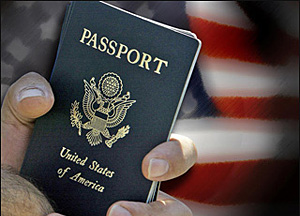 |
 |
 |
 Travel & Outdoors | January 2007 Travel & Outdoors | January 2007  
What You Need to Know About Passport Rules
 Thomas Pierce - NPR Thomas Pierce - NPR


| A list of documents you can currently use to travel.

Passports
Green Cards
Limited-Use Travel Documents

NEXUS Card
Driver's License
Other Valid Travel Documents

U.S. Military Identification
Merchant Mariner Document
Proposed Travel Document

PASS Card |
The U.S. government says about 75 million travelers crossed the northern border in the last fiscal year, less than the 87 million who came by air. Both are dwarfed by the number of visitors crossing the southern border with Mexico: 234 million.

Starting this week, hopping on a flight to Vallarta won't be the same. You might need to wear a jacket with extra pockets, because the U.S. government wants to see more than a driver's license before you return to the United States.

The changes were mandated in 2004, when Congress passed a massive piece of legislation called the Intelligence Reform and Terrorism Prevention Act. In addition to reforming intelligence agencies, the act was designed to increase border protection and beef up transportation security.

More specifically, the act stipulated that the Departments of Homeland Security and State revamp their travel document requirements. The new plan, called the Western Hemisphere Travel Initiative (WHTI), was announced in April 2005. It requires all travelers, including American citizens, to carry a valid passport or other "appropriate documents" when traveling into the United States from anywhere in the Western Hemisphere. That includes Canada, Mexico, Bermuda, the Caribbean and Central and South America. (The new requirements do not apply to U.S. citizens returning from a U.S. territory — such as Puerto Rico and the U.S. Virgin Islands.)

For now, travel by land and sea hasn't changed, though new rules (which are still being worked out) are expected as early as January 2008. But air travel has changed. So before that next big adventure to Canada or Mexico, check out this list of documents you can currently use to cross the border:

• ALL-PURPOSE TRAVEL DOCUMENTS

PASSPORT
What It Is: The passport is still the golden ticket of world travel. U.S. citizens can use their passports when returning to the country by air from Canada, Mexico, Central and South America, the Caribbean and Bermuda. But not everyone has a passport. Only one-fourth of Americans have a passport.

How You Get It: To get a passport for the first time, you'll need a valid form of photo ID, such as a driver's license, proof of U.S. citizenship and two photographs of yourself. Take those to an approved acceptance facility — that includes post offices, some public libraries, federal, state and probate courts and some county and municipal buildings. If you are traveling within 14 days, you can visit one of 13 regional passport agencies, but you'll need an appointment. (Check out the State Department's site for more information.)

When to Use It: For travel from or to anywhere in the world, by air, land or sea.

I-551 FORM (GREEN CARD)
What It Is: Proof of legal residency in the United States for non-U.S. citizens.

How You Get It: See the U.S. Citizenship and Immigration Service's Web site for details.

When to Use It: Permanent U.S. residents can still use their green cards when returning to the United States by land, air or sea in the Western Hemisphere.

• LIMITED-USE TRAVEL DOCUMENTS

NEXUS CARD
What It Is: A card for travel between the U.S. and Canada only.

How You Get It: The card is already available, but only to citizens or permanent residents of Canada or the United States. You can apply for the NEXUS card by submitting an application and going through a registration process. If you satisfy the eligibility criteria and pass the risk assessments of both countries, you'll be issued a card.

When to Use It: You can use the NEXUS card for air travel in conjunction with the NEXUS air program at participating airports. Just insert the card at self-serving kiosks. You'll most likely also be able to use the card for land and sea travel between Canada and the United States, once those rules kick in.

DRIVER'S LICENSE
What It Is: License to drive issued by your state of residency or the District of Columbia.

How You Get It: Check with your local department of motor vehicles.

When to Use It: U.S. citizens crossing the Mexican and Canadian border by land do not technically need any documentation to enter the United States. All they have to do is assert their U.S. citizenship. But if a border agent questions you, be prepared to show a driver's license. A birth certificate or voter registration card will also work as valid ID.

• OTHER VALID TRAVEL DOCUMENTS

U.S. Military Identification: Soldiers on active duty who are traveling by land, air or sea on orders are exempt from passport requirements and can use their valid military identification instead.

Merchant Mariner Document (MMD): U.S. citizen merchant mariners can apply for this document with the U.S. Coast Guard. It allows them to return to the United States by air, land or sea from anywhere in the Western Hemisphere when on official business.

• PROPOSED TRAVEL DOCUMENT

PASS CARD: This card is still just a concept under review by U.S. officials. If it does get developed, it would function as a cheaper alternative for U.S. citizens who do not wish to use a passport for travel only by land and sea between the U.S. and Canada, Mexico, the Caribbean and Bermuda. | 
 | |
 |



